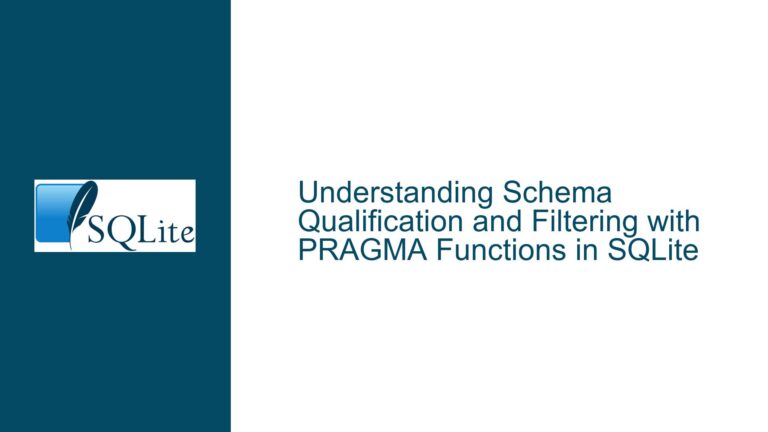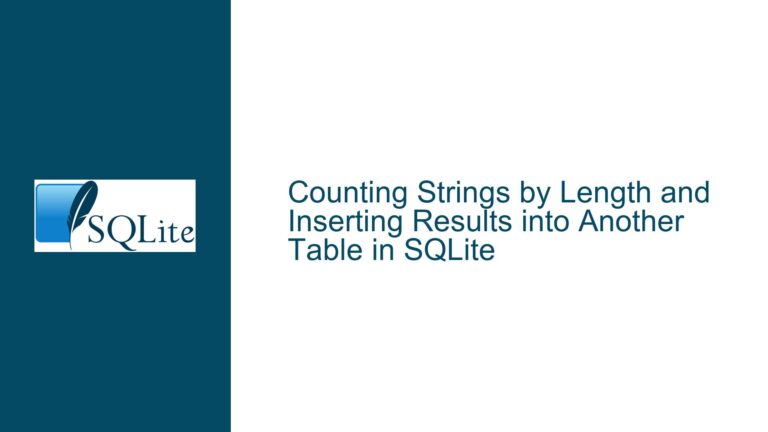SQLite JSON Containment: Testing Subset Inclusion in JSON Documents
Understanding JSON Containment in SQLite
JSON containment refers to the ability to determine whether one JSON document is fully contained within another. This means that all key-value pairs in the first JSON document must exist in the second JSON document, and their values must match. In databases like PostgreSQL, this is achieved using the @> operator, which checks if one JSONB object contains another. However, SQLite does not natively support such an operator, which leads to challenges when trying to perform similar operations.
The core issue revolves around the need to perform JSON containment tests in SQLite, particularly for nested JSON objects. For example, given two JSON documents, json_doc1 and json_doc2, the goal is to determine if json_doc2 is fully contained within json_doc1. This is particularly useful in scenarios where you need to filter or query data based on the presence of specific JSON structures or key-value pairs.
Why JSON Containment is Challenging in SQLite
SQLite’s JSON support is robust but limited compared to PostgreSQL. While SQLite provides functions like json_extract, json_array, and json_object, it lacks a direct way to perform containment tests. This limitation stems from SQLite’s design philosophy, which prioritizes simplicity and lightweight operation over complex, specialized functionality.
The absence of a containment operator means that developers must implement custom logic to achieve similar functionality. This often involves parsing JSON documents, iterating through key-value pairs, and manually comparing them. Such an approach can be error-prone and inefficient, especially when dealing with large or deeply nested JSON documents.
Implementing JSON Containment in SQLite
To implement JSON containment in SQLite, you can leverage SQLite’s JSON functions and some creative SQL queries. The process involves extracting key-value pairs from the JSON documents, comparing them, and ensuring that all pairs in the subset document exist in the target document.
Here’s a step-by-step approach to achieve JSON containment in SQLite:
Extract Key-Value Pairs: Use the
json_eachfunction to extract key-value pairs from both JSON documents. This function returns a table with columnskeyandvalue, which can be used for comparison.Compare Key-Value Pairs: For each key-value pair in the subset JSON document, check if it exists in the target JSON document. This can be done using a combination of
json_extractand conditional logic.Handle Nested JSON: If the JSON documents contain nested objects or arrays, you’ll need to recursively apply the above steps. This can be complex and may require the use of Common Table Expressions (CTEs) or recursive queries.
Return Result: If all key-value pairs in the subset JSON document are found in the target JSON document, return
true; otherwise, returnfalse.
Here’s an example query that demonstrates this approach:
WITH subset AS (
SELECT key, value
FROM json_each('{"foo": {"bar": "baz"}}')
),
target AS (
SELECT key, value
FROM json_each('{"foo": {"bar": "baz", "foo": "doo"}}')
)
SELECT NOT EXISTS (
SELECT 1
FROM subset
WHERE NOT EXISTS (
SELECT 1
FROM target
WHERE target.key = subset.key
AND target.value = subset.value
)
) AS is_contained;
In this query, the subset CTE extracts key-value pairs from the subset JSON document, and the target CTE does the same for the target JSON document. The main query then checks if all key-value pairs in the subset exist in the target. If they do, the query returns true; otherwise, it returns false.
Optimizing JSON Containment Queries
While the above approach works, it may not be efficient for large JSON documents or high-frequency queries. To optimize JSON containment queries in SQLite, consider the following strategies:
Indexing JSON Data: If you frequently query specific keys within JSON documents, consider creating virtual columns or indexes on those keys. This can significantly speed up queries by reducing the need to parse JSON documents repeatedly.
Preprocessing JSON Data: If possible, preprocess JSON data to flatten nested structures or extract frequently accessed keys into separate columns. This can simplify queries and improve performance.
Using JSON Functions Efficiently: Minimize the use of expensive JSON functions like
json_eachin high-frequency queries. Instead, cache or precompute results where possible.Leveraging SQLite Extensions: SQLite supports extensions that can add additional functionality. If JSON containment is a critical requirement, consider developing or using an extension that provides this functionality.
Handling Edge Cases in JSON Containment
When implementing JSON containment in SQLite, it’s important to handle edge cases that may arise. These include:
Nested Objects: Ensure that your containment logic correctly handles nested JSON objects. This may require recursive queries or additional logic to traverse the JSON structure.
Arrays: JSON arrays can complicate containment tests, especially if the order of elements matters. Decide whether arrays should be treated as sets (where order and duplicates are ignored) or as ordered lists.
Data Types: JSON supports various data types, including strings, numbers, booleans, and null. Ensure that your containment logic correctly compares these data types, taking into account any type coercion that may occur.
Missing Keys: If a key exists in the subset JSON document but not in the target JSON document, the containment test should return
false. Ensure that your logic correctly handles missing keys.
Alternative Approaches to JSON Containment
If the above methods are too complex or inefficient for your use case, consider alternative approaches to achieve JSON containment in SQLite:
Application-Level Logic: Instead of performing JSON containment in SQLite, handle it in your application code. This allows you to use more sophisticated JSON libraries and logic, but may increase the complexity of your application.
Hybrid Approach: Combine SQLite’s JSON functions with application-level logic. For example, use SQLite to extract key-value pairs and application code to perform the containment test.
Database Migration: If JSON containment is a critical requirement, consider migrating to a database that natively supports this functionality, such as PostgreSQL. This may not always be feasible, but it’s worth considering if JSON containment is a core part of your application.
Conclusion
JSON containment is a powerful feature that allows you to query and filter data based on the presence of specific JSON structures. While SQLite does not natively support JSON containment, you can achieve similar functionality using a combination of SQLite’s JSON functions and custom logic. By understanding the challenges and implementing the strategies outlined above, you can effectively perform JSON containment tests in SQLite, even in complex scenarios involving nested objects and arrays.
Remember to optimize your queries, handle edge cases, and consider alternative approaches if necessary. With careful planning and implementation, you can leverage SQLite’s JSON capabilities to meet your application’s needs.






